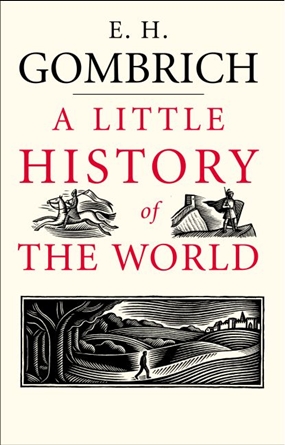This book, A Little History of the World (ISBN 978-0-300-14332-4, Yale University Press, first paperback edition (in English 2008, but was first published in German in 1936) was written by Art historian E.H. Gombrich.
There are 40 chapters covering Egypt, Moses and his God but also Mohammad and Allah, knights and empires, and the ‘current’ history of the world as he knew and experienced it, plus another 34 chapters!

The history of the Jews and the misfortunes that befell them is simply put, and very understandable. While the Jews may not have trusted their neighbors, their neighbors did not trust them either! The parallel to today is brought to mind. History does repeat itself!
Many interesting facts are brought out, such as where the term ‘Marathon’ run came from (it was a runner who had to warn the Athenians of a Persian attack, and who dropped dead after delivering his message).
The Great Wall of China owes its existence to the ruler Shih Huang-ti, and in that chapter Gombrich shows the importance of history by referring to what happened after Shih Huang-ti tried to ban all references to the past.
Do you know just how Attila the Hun was so successful? Gombrich did and chapter 18 holds the answer. And how Muhammad came to be the prophet after a visit from the Archangel Gabriel – that’s in chapter 20.
I found the elevation to a knight by the sons of knights very interesting, with the various steps which had to be done, ending in the culmination of being bestowed the title of knight at age 21, with the flat blade of a sword placed on his neck. Gombrich’s book also showed that in what was considered the age of chivalry, not all crusades were carried out in a chivalrous manner.
The significance of 1492 is explored, with Columbus’ (accidental) discovery of America, and explanation of why the American aborigines are called “Indians” and why we have the West Indies and the East Indies.
Not all the famous figures in history can be covered in the Little History of the World, but certain notables are in its pages, such as Montezuma of Mexico who thought that Cortez and the Spanish troops were the gods predicted in their own writings. However, history has shown that Cortez was anything but a god.
The final chapter refers to World War II, and for Gombrich, born in Vienna, this represents a very low point in human existence, and one that causes him personal embarrassment, though he writes that as children grow up, they deserve to know the truth.
As a book on the history of the world, written for children, it comes across as a wonderful collection of subjects, dealing in some way or other with the history of the world, or as much as author E.H. Gombrich knew of it. The chapters are all short (generally around six pages), and can be read and understood by children from the age of 14, the book is just as easily enjoyed by adults. A masterpiece of narrative writing.
B. 655 in Bookazine.




